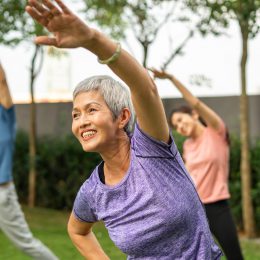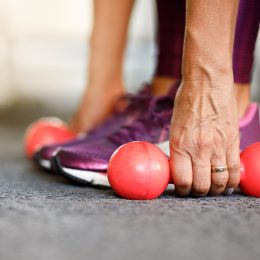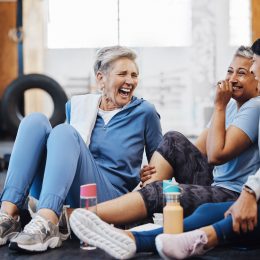5 Best Upper-Body Exercises for Older Adults (That Aren’t Pushups)
Build the strength you need to stay independent and pain-free with these pushup alternatives.
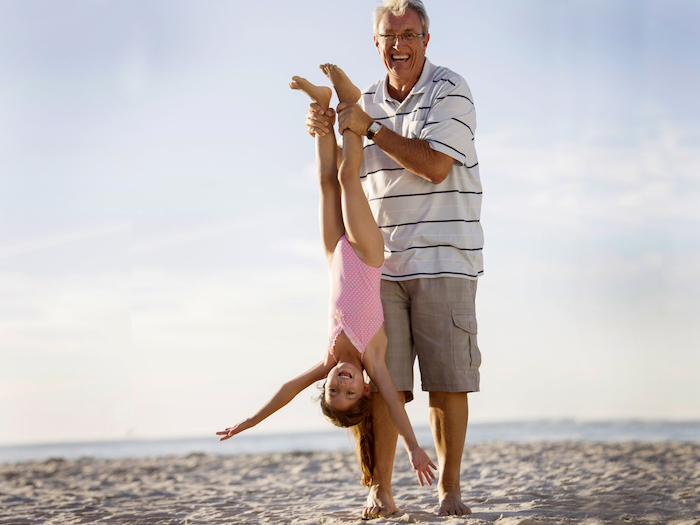
If you want to maintain your independence longer, you can’t ignore upper-body strength.
“We go through life and have to be able to push things and pull things,” says Jason Machowsky, R.D., C.S.C.S., a sports performance specialist at the Hospital for Special Surgery in New York. “From opening a door to lifting grocery bags to opening a window or jars, upper-body strength gives us the ability to do these daily activities.”
Plus, many older adults enjoy playing sports like tennis and golf, which take a certain amount of upper-body strength and mobility to do well, he says.
Unless you make an effort to build or maintain your muscle, it won’t stick around forever. Age-related decline in muscle mass, also known as sarcopenia, starts around age 40 and continues at a steady rate until up to 50 percent of our muscle is gone by age 80, according to a review in the journal Current Opinion in Rheumatology.
What’s more, sarcopenia is most pronounced in lower-body muscles, which means the upper body has to kick in to help you push yourself up from a chair, get out of bed, or perhaps use a walker. Upper-body strength is especially important for helping maintain your mobility and independence, says Erika Mundinger, D.P.T., a physical therapist at TRIA Orthopaedic in Bloomington, Minnesota.
Now for some good news: Anyone can build and maintain functional upper-body strength with a bit of resistance training. In fact, a small study in the Journal of Aging and Physical Activity found that just 16 total sessions of upper-body resistance training in six weeks significantly improved functional strength in older adults.
“Strength training prevents compensatory movement patterns that ultimately lead to further degeneration and compression of arthritic joints,” Mundinger says. “Strength training also helps circulate the nutrients you need for healthy muscle tissues, fibers, and the joints your muscles attach to,” she says.
When it comes to building functional upper-body strength, it’s tough to beat the traditional pushup. This multi-joint movement works your chest, shoulders, triceps, and core, while also challenging your lower body. But pushups can be challenging or even painful for many older adults, primarily due to osteoarthritis in the shoulders, spinal degeneration, and loss of muscle mass, Mundinger says.
One option is to modify the pushup by elevating your hands on a wall or countertop. This body position may allow you to feel the movement in your chest and core without compensation from surrounding muscles. But if you feel any pain or that your form is compromised, you’re better off trying an alternative upper-body exercise.
The 5 Best Pushup Alternatives
The five moves below offer similar strength- and stability-boosting benefits as the pushup. You can pick two or three to add to your weekly routine, or simply pick one to swap in for pushups whenever a workout or group fitness class calls for them.
“The most important thing is that you feel the exercise in the right places [your chest, arms, and core] and you’re lifting to moderate fatigue,” Machowsky says.
That means if you’re asked to perform 10 reps, you should end your set feeling like you could maybe do two more reps with perfect form, but no more than that. If you could knock out three or more additional reps, you need to increase the weight you’re lifting.
As always, safety is key. The exercises here may be different or more advanced than those you’ll experience in a SilverSneakers class. If you have a chronic condition, an injury, or balance issues, talk to your doctor about how you can exercise safely.
Upper-Body Exercise #1: Chest Press
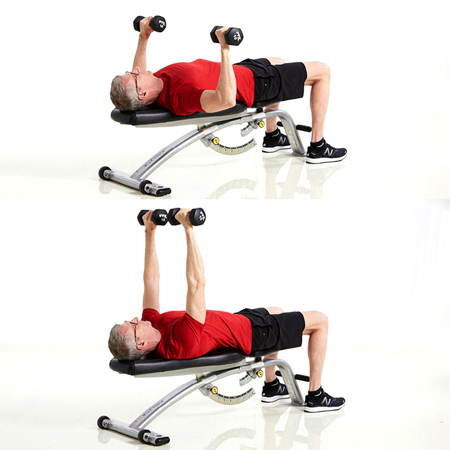
Grab a dumbbell in each hand, and lie faceup on a bench. Position the dumbbells just outside of and above your chest, palms facing away from your body. If you have cranky shoulders, try angling the dumbbells so that your palms face each other. Your elbows should flare about 45 degrees away from your torso. Do not let them flare straight out from your sides. Brace your core to press your low back into the bench. This is your starting position.
From here, press the weights up and together until your arms are straight, but not locked out. Pause, then slowly lower the weights to return to start. That’s one rep. Perform two sets of six to 10 reps, resting for 30 to 60 seconds between sets.
Upper-Body Exercise #2: Floor Press
This exercise is very similar to the chest press, but you’ll lie on the floor instead of on a bench. Using the floor helps remove potential strain on your shoulder joints. Grab a dumbbell in each hand, and lie faceup on the floor with knees bent and feet firmly planted. Extend elbows to a 90-degree position with triceps (backs of upper arms) resting on the floor and dumbbells above your chest. This is your starting position.
Exhale and brace your core while pressing the weights up and together until your arms are straight, but not locked out. Pause, then slowly lower the weights to return to start. That’s one rep. Perform two sets of six to 10 reps, resting for 30 to 60 seconds between sets.
Upper-Body Exercise #3: Chest Fly
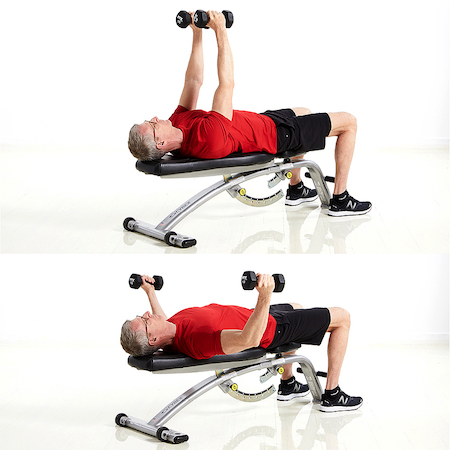
Grab a dumbbell in each hand, and lie faceup on a bench or on the floor. Hold the dumbbells above your chest with elbows slightly bent and palms facing each other. This is your starting position.
Subscribe to our newsletter
It's quick and easy. You could be one of the 13 million people who are eligible.
Already a member? Click to discover our 15,000+ participating locations.
Follow Us
Without changing the bend in your elbows, slowly lower the dumbbells down and slightly back until your upper arms are parallel to the floor. If you’re not on a bench, lower until your elbows touch the floor. Pause, then lift the dumbbells back to the starting position. That’s one rep. Perform two sets of six to 10 reps, resting for 30 to 60 seconds between sets.
Cautionary note: If you have preexisting shoulder pain, this move may aggravate it so concentrate on engaging your abdominals, Machowsky says. If you still feel it in your shoulders, skip this exercise, and try chest or floor presses instead.
Upper-Body Exercise #4: Bird Dog
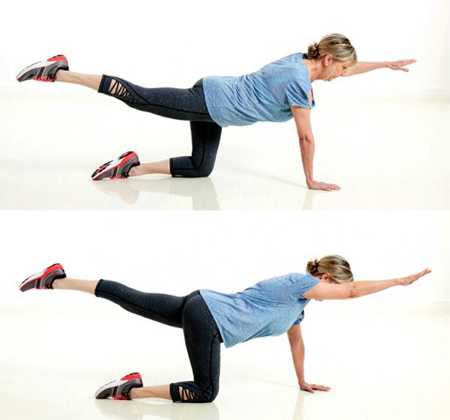
Start on all fours with your hands below your shoulders and knees below your hips. Engage your core, keep your spine neutral, and gaze down or slightly forward.
Lift your left arm and extend your right leg until they are in line with the rest of your body. Pause, then lower back down, and repeat on the opposite side with right arm and left leg extended. That’s one rep. Perform two sets of six to 10 reps, resting for 30 to 60 seconds between sets.
Upper-Body Exercise #5: Bent-Arm Plank
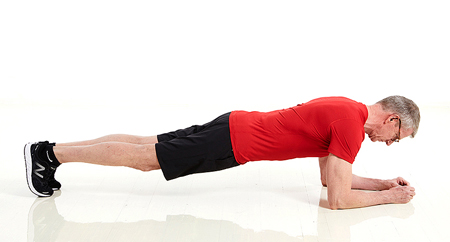
Lie on your stomach on the floor with your elbows directly underneath your shoulders and forearms flat on the floor. Focus your eyes between your hands. Your legs should be resting behind you, knees hip-width apart (or slightly farther apart for extra balance).
From here, lift your hips toward the ceiling until your body forms a straight line from head to ankles, and squeeze your upper back, core, and glutes. Hold this position for one minute.
If that’s too challenging, hold your plank as long as possible, rest, and repeat until you reach one minute total. Or do the move with your knees on the floor, and lift your hips so your body forms a straight line from head to knees.
Take Your Favorite SilverSneakers Classes Online!
SilverSneakers members can access live fitness classes and wellness workshops through SilverSneakers LIVE. See the latest schedule and RSVP for classes here.
Not a member? If you have a Medicare Plan, it may include SilverSneakers—at no additional cost. Check your eligibility instantly here.


